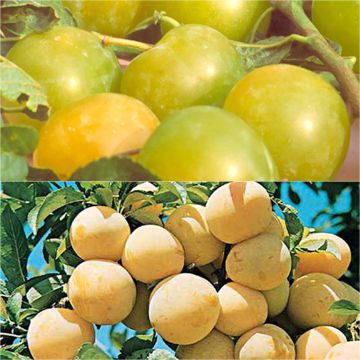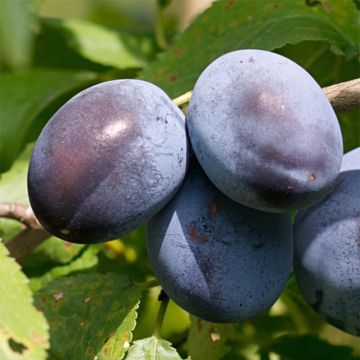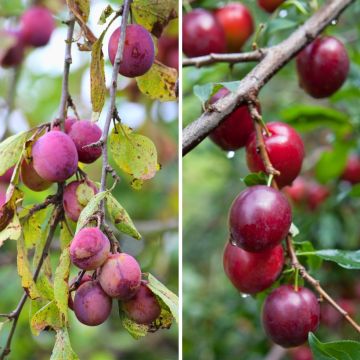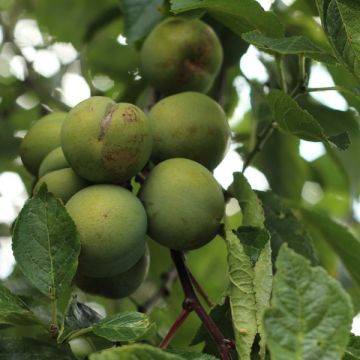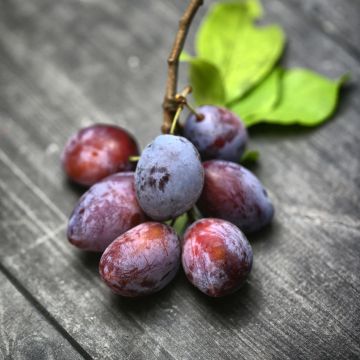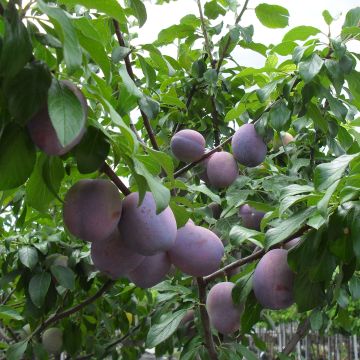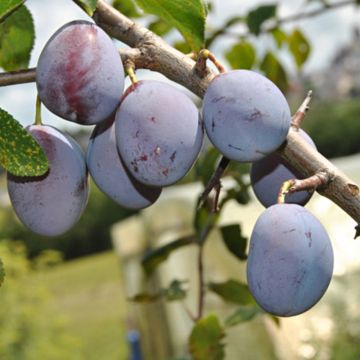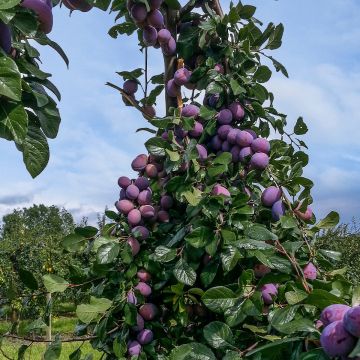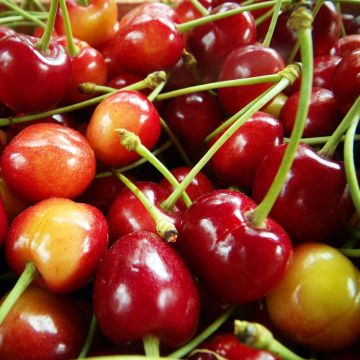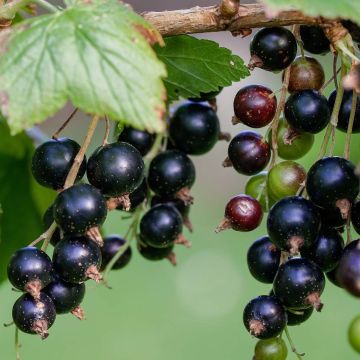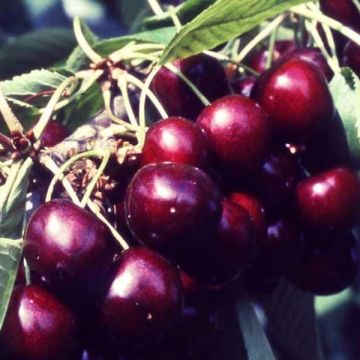

Prunier japonais Allo - Prunus salicina


Prunier japonais Allo - Prunus salicina
Japanese Plum Allo Organic - Prunus salicina
Prunus x salicina Allo
Japanese plum, Chinese plum
Package well packed, tree well supplied, a pity that the central tip bristle is cut, preventing me from training it into a standard.
Jeanjacques , 07/12/2024
Special offer!
Receive a €20 voucher for any order over €90 (excluding delivery costs, credit notes, and plastic-free options)!
1- Add your favorite plants to your cart.
2- Once you have reached €90, confirm your order (you can even choose the delivery date!).
3- As soon as your order is shipped, you will receive an email containing your voucher code, valid for 3 months (90 days).
Your voucher is unique and can only be used once, for any order with a minimum value of €20, excluding delivery costs.
Can be combined with other current offers, non-divisible and non-refundable.
Home or relay delivery (depending on size and destination)
Schedule delivery date,
and select date in basket
This plant carries a 6 months recovery warranty
More information
We guarantee the quality of our plants for a full growing cycle, and will replace at our expense any plant that fails to recover under normal climatic and planting conditions.
Description
Prunus x salicina 'Allo' is a vigorous, hardy variety that provides abundant and regular harvests. It produces a large-sized plum, reaching 100 to 120 grams in weight, with a rounded shape and thin skin. They are red, tinged with pink when ripe. Its orange-yellow flesh is firm, juicy, melting, delicately sweet and aromatic, with a small stone that separates easily from the pulp. Harvesting begins in early July. The fruits are suitable for fresh consumption and processing. The early flowering of this plum tree is perfect for mild regions or sheltered areas. This variety is partially self-fertile, and the presence of another flowering plum tree nearby at the same time will ensure good pollination. It thrives in ordinary, well-drained, moist, deep and fertile soil that is not excessively chalky. It does not like stagnant moisture.
Prunus x salicina (Japanese plum) belongs to the Rosaceae family, just like the apricot tree, almond tree, and peach tree. It is native to subtropical regions of southern China, where it grows on the edge of woods, along paths or in sparsely wooded areas. It was imported to Japan between 200 and 400 years ago, and then to the United States from 1870 onwards. 'Allo' is a hybrid variety of Japanese plum with somewhat uncertain origins.
'Allo' forms a fruit tree with a fairly rounded framework that can reach a final height of approximately 5 to 6m (16 to 20ft), producing brownish branches grouped in spreading crowns. Its habit is ideal for free forms on high, half, or low stems. Its deciduous foliage consists of dark green oblong leaves, 6 to 9cm (2 to 4in) long and 3 to 5cm (1 to 2in) wide, with finely toothed edges. In late March and early April, it produces white flowers, 1.5 to 2.5cm (1in) in diameter. They appear solitarily, before the leaves, on the previous year's branches. The flowering can be sensitive to spring frosts, which is why it is wise to grow it in mild regions. In other cases, it can be grown in positions sheltered from the cold. The abundant blooms are particularly attractive to bees and butterflies. It is a hardy tree, tolerating temperatures as low as -15°C (5°F). This plum tree is self-sterile, meaning the flowers cannot fertilise themselves. The presence of other plum varieties nearby, flowering at the same time, is necessary. For example, the 'Golden Reine Claude', 'Oullins Reine Claude', 'Quetsche d'Alsace', 'Quetsche d'Italie', 'Methley', 'Mirabelle de Metz', 'Mirabelle de Nancy', and 'Victoria' varieties are suitable for cross-pollination, thereby increasing fruit production.
Prunus x salicina 'Allo' bears fruit quickly. The plums are harvested from early July to early August, and can be consumed as they ripen. Since plums are quite delicate, they should be harvested with a picking pole or manually using a ladder, always with care. An average plum tree yields between 50 and 70 kilograms of fruit per year. The large plums measure 4 to 6cm (2in) in diameter. They boast smooth and delicious flesh. Plums can be eaten raw right after picking, as a snack or mixed into fruit salads, or as a dessert. They are also excellent for making clafoutis, cakes, crumbles, or pies, and as an accompaniment to savoury dishes with white meats (turkey, chicken, veal, etc.) or tagines. They are also perfect for making jams, compotes, or preserved fruits in syrup. In China, these Japanese varieties are used to make plum candies with reputed digestive properties.
Plums are a light and balancing fruit. Low in calories, they are rich in potassium, calcium, and magnesium, with a significant iron content. They contain vitamins C, B, E, and K, phenolic antioxidants, and fibre. They are invigorating, energising, and rehydrating. The fruits can only be stored for a few days at room temperature. However, they can be frozen after washing, drying, and pitting, or preserved in jams or syrup.
In the plum - Mirabelle category, Prunus salicina 'Allo' can be used in many ways. In favourable conditions it is easy to grow, generous in fruit production, and resistant to diseases. Extremely popular for its fruits, the plum tree finds its rightful place in the garden, bringing joy to both young and old. With a wide range of varieties, it is easy to find a plum that best suits one's preferences.
Report an error about the product description
Japanese Plum Allo Organic - Prunus salicina in pictures


Plant habit
Fruit
Flowering
Foliage
Botanical data
Prunus
x salicina
Allo
Rosaceae
Japanese plum, Chinese plum
Cultivar or hybrid
Other Plum Trees
View all →Planting and care
It withstands temperatures below -15°C (5°F) and can be cultivated up to an altitude of 1000m. When grown in good conditions, it is one of the easiest fruit trees to cultivate, as it is both generous and resistant. Plum trees bloom early in spring and are therefore exposed to frost, although frost rarely affects plum harvests. Avoid areas that are too exposed to north and east winds in colder regions. To produce beautiful fruit, the plum tree appreciates warm and sunny locations sheltered from strong winds (the branches are very brittle). It is a vigorous tree that thrives in all types of soil, although it prefers rich, moist, deep, well-drained soil that is slightly acidic, without stagnant moisture or excessive limestone. It truly only fears waterlogged soil. The plum tree is only grown in free-form shapes. With its white blossoms, it brings a touch of freshness to both natural gardens and orchards in spring.
Plant from November to March during the vegetative rest period, excluding periods of frost. Container-grown trees can be planted all year round, provided that the soil is neither frozen nor waterlogged. Don't forget to prune and coat the bare roots before planting. In open ground, you can plant plum trees in groups of 3 or 5, spacing the trees 6 to 7m apart.
Prepare the soil well. Dig a wide planting hole at least 3 times the size of the root ball (80x80cm). Add gravel to improve drainage. Place the tree in the hole and plant a stake without tying it too tightly. Fill in and tamp down the soil gradually with garden soil enriched with compost, well-rotted manure, and 2 or 3 handfuls of crushed horn. Do not bury the graft collar (leave the graft point 10cm (4in) above the ground level). Create a basin around the base and water abundantly and regularly to help your plum tree establish itself.
After planting, water regularly for the first three years, as the soil must remain moist throughout summer. It does not like excessively dry soil. If there is a lack of water, its fruit may fall prematurely. After 2 or 3 years, it will better withstand a short period of drought. Mulch the base of your plum tree during the first few years with dry vegetation (bark, dead leaves, straw, etc.) to keep it cool in summer.
If necessary, thin out the fruit.
Ripe plums attract wasps. Collect fallen fruit from the ground.
If necessary, remove any shoots that have grown over time at the base of the tree. Be careful when hoeing as its roots are shallow.
In autumn or spring, apply manure or fertiliser for fruit trees.
Planting period
Intended location
Care
-
, onOrder confirmed
Reply from on Promesse de fleurs
Similar products
Haven't found what you were looking for?
Hardiness is the lowest winter temperature a plant can endure without suffering serious damage or even dying. However, hardiness is affected by location (a sheltered area, such as a patio), protection (winter cover) and soil type (hardiness is improved by well-drained soil).

Photo Sharing Terms & Conditions
In order to encourage gardeners to interact and share their experiences, Promesse de fleurs offers various media enabling content to be uploaded onto its Site - in particular via the ‘Photo sharing’ module.
The User agrees to refrain from:
- Posting any content that is illegal, prejudicial, insulting, racist, inciteful to hatred, revisionist, contrary to public decency, that infringes on privacy or on the privacy rights of third parties, in particular the publicity rights of persons and goods, intellectual property rights, or the right to privacy.
- Submitting content on behalf of a third party;
- Impersonate the identity of a third party and/or publish any personal information about a third party;
In general, the User undertakes to refrain from any unethical behaviour.
All Content (in particular text, comments, files, images, photos, videos, creative works, etc.), which may be subject to property or intellectual property rights, image or other private rights, shall remain the property of the User, subject to the limited rights granted by the terms of the licence granted by Promesse de fleurs as stated below. Users are at liberty to publish or not to publish such Content on the Site, notably via the ‘Photo Sharing’ facility, and accept that this Content shall be made public and freely accessible, notably on the Internet.
Users further acknowledge, undertake to have ,and guarantee that they hold all necessary rights and permissions to publish such material on the Site, in particular with regard to the legislation in force pertaining to any privacy, property, intellectual property, image, or contractual rights, or rights of any other nature. By publishing such Content on the Site, Users acknowledge accepting full liability as publishers of the Content within the meaning of the law, and grant Promesse de fleurs, free of charge, an inclusive, worldwide licence for the said Content for the entire duration of its publication, including all reproduction, representation, up/downloading, displaying, performing, transmission, and storage rights.
Users also grant permission for their name to be linked to the Content and accept that this link may not always be made available.
By engaging in posting material, Users consent to their Content becoming automatically accessible on the Internet, in particular on other sites and/or blogs and/or web pages of the Promesse de fleurs site, including in particular social pages and the Promesse de fleurs catalogue.
Users may secure the removal of entrusted content free of charge by issuing a simple request via our contact form.
The flowering period indicated on our website applies to countries and regions located in USDA zone 8 (France, the United Kingdom, Ireland, the Netherlands, etc.)
It will vary according to where you live:
- In zones 9 to 10 (Italy, Spain, Greece, etc.), flowering will occur about 2 to 4 weeks earlier.
- In zones 6 to 7 (Germany, Poland, Slovenia, and lower mountainous regions), flowering will be delayed by 2 to 3 weeks.
- In zone 5 (Central Europe, Scandinavia), blooming will be delayed by 3 to 5 weeks.
In temperate climates, pruning of spring-flowering shrubs (forsythia, spireas, etc.) should be done just after flowering.
Pruning of summer-flowering shrubs (Indian Lilac, Perovskia, etc.) can be done in winter or spring.
In cold regions as well as with frost-sensitive plants, avoid pruning too early when severe frosts may still occur.
The planting period indicated on our website applies to countries and regions located in USDA zone 8 (France, United Kingdom, Ireland, Netherlands).
It will vary according to where you live:
- In Mediterranean zones (Marseille, Madrid, Milan, etc.), autumn and winter are the best planting periods.
- In continental zones (Strasbourg, Munich, Vienna, etc.), delay planting by 2 to 3 weeks in spring and bring it forward by 2 to 4 weeks in autumn.
- In mountainous regions (the Alps, Pyrenees, Carpathians, etc.), it is best to plant in late spring (May-June) or late summer (August-September).
The harvesting period indicated on our website applies to countries and regions in USDA zone 8 (France, England, Ireland, the Netherlands).
In colder areas (Scandinavia, Poland, Austria...) fruit and vegetable harvests are likely to be delayed by 3-4 weeks.
In warmer areas (Italy, Spain, Greece, etc.), harvesting will probably take place earlier, depending on weather conditions.
The sowing periods indicated on our website apply to countries and regions within USDA Zone 8 (France, UK, Ireland, Netherlands).
In colder areas (Scandinavia, Poland, Austria...), delay any outdoor sowing by 3-4 weeks, or sow under glass.
In warmer climes (Italy, Spain, Greece, etc.), bring outdoor sowing forward by a few weeks.






























